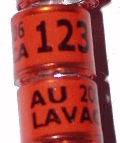|
On weekends in the Spring and Fall, thousands of racing pigeon fanciers have birds competing in
races at distances from 100 to 600 miles.
Pigeon races are conducted by releasing "liberating" the birds from one or more groups of
fanciers "clubs" that are racing together at a
common point "race station" and are timed as they fly back
to their home "loft".
Multiple clubs in a geographic area group together into increasing larger
organizations, named combines, concourses or associations,
to increase the number of birds competing together.
Only birds released at the same time, at the same release point, may
compete against each other.
Each bird flies to its own loft. Each competing loft has a different
distance from the release point since they are located in different geographic places.
The winning bird is the bird with highest velocity, the distance
to home divided by the bird's elapsed time to return. Given that the lofts have different
distances, the shortest elapsed time in not necessarily the winner.
Each bird is banded with a permanent id band containing the year issued
and unique set of letters and sequence number. For competetion the
birds carry another special band, that when used in conjunction with a timing
clock at the loft, provides proof of bird arrival and time.

| Band example: AU-2005-LAVACA-123 |
| |
| AU | National Organization (AU, IF, CU, BELG, etc.) |
2005 | Issue year |
LAVACA | Club or owner |
123 | Sequence number |
Liberation time is the time the birds are released to start the
race, arrival time is the time the bird is recorded as arriving at home
and flying time is the elapsed
time from liberation to arrival.
The winning birds usually fly in the range of 30 to 50 MPH depending on the
race distance, weather conditions, wind speed and wind direction.
The distance from liberation station to the loft is measured to 1/1000th miles
and the flying time is measured as hours, minutes and seconds.
Pigeon race velocities are reported
using units of Yards per Minute (YPM).
(miles * 1760 * 60) / seconds = YPM
(miles * (yards/mile) * (seconds/minute)) / seconds
Usually races are grouped into a Series of races at
varying distances.
Old Bird series are flown in the Spring, typically at distances of 100mi to 600mi,
and are open to birds of any age.
Young Bird series are flown in the Fall, typically at distances of 100mi to 300mi,
and are open to birds banded in that year.
| 


